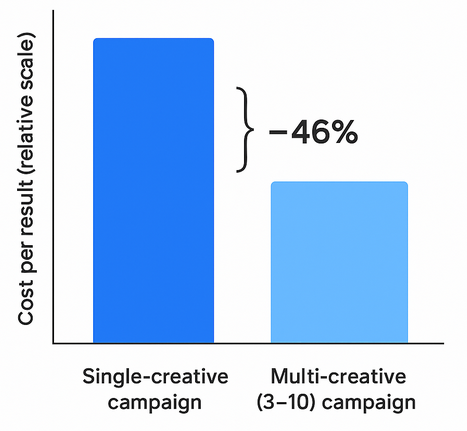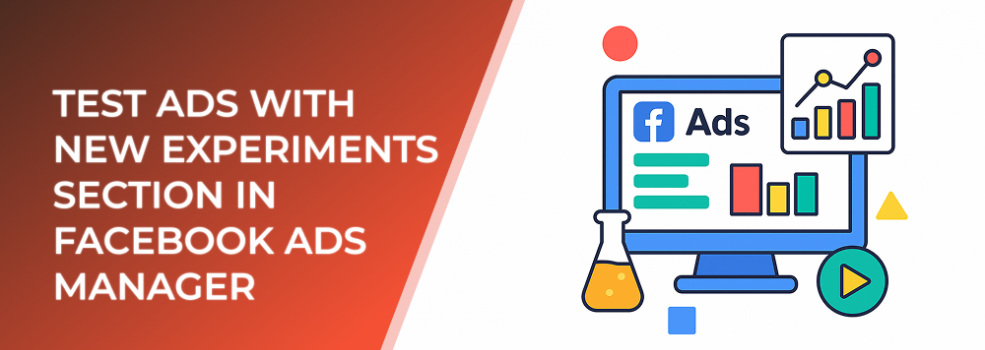Meta has consolidated several testing tools into a unified Experiments interface, allowing advertisers to quickly set up A/B tests, holdout tests, and conversion lift studies in one streamlined panel. This centralization reduces setup complexity and helps ensure test integrity.
Testing matters because small performance improvements compound. According to Meta data, advertisers who test creatives regularly achieve up to 30% lower cost per result across campaigns. Structured testing provides clarity instead of relying on assumptions.
What You Can Test
The Experiments section allows you to compare nearly any performance-driving variable:
1. Creatives
Run A/B tests comparing formats, messaging angles, calls to action, or color variations. Creatives are often the most impactful variable: research shows that creative quality contributes up to 56% of advertising performance.
2. Audiences
Test interest audiences, custom audiences, lookalikes, and broad targeting. For many advertisers, audience testing reveals large efficiency gaps. Some tests show cost per result differences of more than 40% between audience segments.
3. Placements
Evaluate Performance across Facebook, Instagram, Messenger, and Audience Network. In many cases, Instagram Feed and Reels deliver 10–25% higher engagement rates compared to Facebook Feed.
4. Optimization Goals
Test conversion vs landing page views, link clicks vs conversions, or purchase vs add-to-cart optimization. Advertisers commonly find that using the correct optimization event increases conversion rate by 20–40%.
How to Use the New Experiments Section
Step 1: Access the Experiments Panel
Within Ads Manager, the Experiments tab provides all testing tools in one place. You can create tests without navigating multiple menus.
Step 2: Choose the Test Type
The main types include:
-
A/B Test – Compares two variables and identifies a statistically significant winner.
-
Holdout Test – Shows incremental lift by comparing exposed vs unexposed users.
-
Conversion Lift – Measures true incremental conversions created by ads.
Step 3: Select Variables to Test
Choose what you want to test – creative, audience, placement, or optimization event.
Step 4: Set Budget and Duration
For statistically valid results, Meta recommends:
-
Running tests at least 7 days
-
Allocating sufficient budget so each variant receives meaningful delivery
For many advertisers, a minimum of 20–30 conversions per variant is necessary to ensure reliable data.
Step 5: Launch and Monitor
The Experiments section displays performance differences clearly. Once a test reaches significance, you receive a winner recommendation inside Ads Manager.
Best Practices for Accurate Results
1. Test One Variable at a Time
Testing multiple variables reduces clarity. One-variable testing ensures clean and interpretable outcomes.
2. Avoid Rapid Edits
Changing budgets or settings mid-test compromises data quality.
3. Let the Test Finish
Premature decisions lead to misleading direction. Statistical significance usually requires 7–14 days depending on budgets.
4. Retest Regularly
As platforms, algorithms, and user behavior change, tests become outdated quickly. Many advertisers run monthly or quarterly test cycles.
Example Tests That Deliver Fast Wins
Test Idea 1: Creative Format

Mobile-optimized vertical video ads deliver ~12% higher conversion rate than non-optimized formats
Compare static vs short-form video. Many advertisers report that video generates 20–50% higher click-through rates.
Test Idea 2: Audience Quality
Compare broad targeting vs lookalike audiences. In numerous cases, lookalikes produce up to 25% lower cost per acquisition.
Test Idea 3: Optimization Event
Test purchase optimization vs add-to-cart optimization. Purchase optimization often improves conversion rate by 15–30%.
Why Experiments Improve ROI
Testing eliminates guesswork. Advertisers who adopt structured experimentation:
-
Reduce wasted spend
-
Increase conversion efficiency
-
Better understand what truly influences performance

Using multiple creatives reduces cost per result by ~46% compared with single-creative campaigns
Meta reports that brands regularly running tests see on average 20% more efficient outcomes across their campaigns.
Suggested Articles to Read Next
-
Audience Targeting Strategies for Scalable Growth
-
Creative Testing: How to Find Winning Ads Faster
-
A/B Testing for Ad Creatives: Complete Workflow
This updated Experiments section gives advertisers a powerful, simple, and data-driven way to optimize campaigns and reliably improve results.

